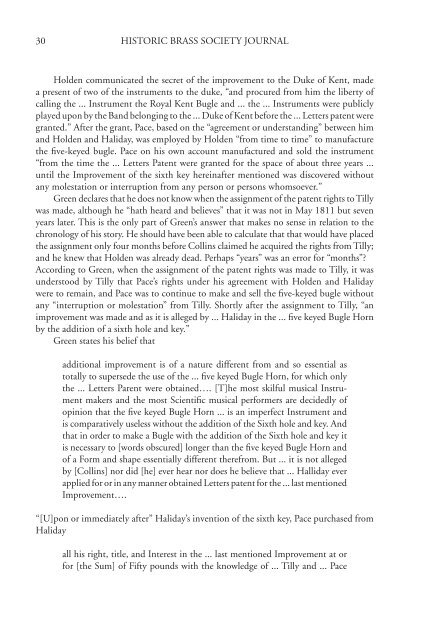New Light on the Early History of the Keyed Bugle Part I: The Astor ...
New Light on the Early History of the Keyed Bugle Part I: The Astor ...
New Light on the Early History of the Keyed Bugle Part I: The Astor ...
You also want an ePaper? Increase the reach of your titles
YUMPU automatically turns print PDFs into web optimized ePapers that Google loves.
30<br />
HISTORIC BRASS SOCIETY JOURNAL<br />
Holden communicated <strong>the</strong> secret <strong>of</strong> <strong>the</strong> improvement to <strong>the</strong> Duke <strong>of</strong> Kent, made<br />
a present <strong>of</strong> two <strong>of</strong> <strong>the</strong> instruments to <strong>the</strong> duke, “and procured from him <strong>the</strong> liberty <strong>of</strong><br />
calling <strong>the</strong> ... Instrument <strong>the</strong> Royal Kent <strong>Bugle</strong> and ... <strong>the</strong> ... Instruments were publicly<br />
played up<strong>on</strong> by <strong>the</strong> Band bel<strong>on</strong>ging to <strong>the</strong> ... Duke <strong>of</strong> Kent before <strong>the</strong> ... Letters patent were<br />
granted.” After <strong>the</strong> grant, Pace, based <strong>on</strong> <strong>the</strong> “agreement or understanding” between him<br />
and Holden and Haliday, was employed by Holden “from time to time” to manufacture<br />
<strong>the</strong> five-keyed bugle. Pace <strong>on</strong> his own account manufactured and sold <strong>the</strong> instrument<br />
“from <strong>the</strong> time <strong>the</strong> ... Letters Patent were granted for <strong>the</strong> space <strong>of</strong> about three years ...<br />
until <strong>the</strong> Improvement <strong>of</strong> <strong>the</strong> sixth key hereinafter menti<strong>on</strong>ed was discovered without<br />
any molestati<strong>on</strong> or interrupti<strong>on</strong> from any pers<strong>on</strong> or pers<strong>on</strong>s whomsoever.”<br />
Green declares that he does not know when <strong>the</strong> assignment <strong>of</strong> <strong>the</strong> patent rights to Tilly<br />
was made, although he “hath heard and believes” that it was not in May 1811 but seven<br />
years later. This is <strong>the</strong> <strong>on</strong>ly part <strong>of</strong> Green’s answer that makes no sense in relati<strong>on</strong> to <strong>the</strong><br />
chr<strong>on</strong>ology <strong>of</strong> his story. He should have been able to calculate that that would have placed<br />
<strong>the</strong> assignment <strong>on</strong>ly four m<strong>on</strong>ths before Collins claimed he acquired <strong>the</strong> rights from Tilly;<br />
and he knew that Holden was already dead. Perhaps “years” was an error for “m<strong>on</strong>ths”?<br />
According to Green, when <strong>the</strong> assignment <strong>of</strong> <strong>the</strong> patent rights was made to Tilly, it was<br />
understood by Tilly that Pace’s rights under his agreement with Holden and Haliday<br />
were to remain, and Pace was to c<strong>on</strong>tinue to make and sell <strong>the</strong> five-keyed bugle without<br />
any “interrupti<strong>on</strong> or molestati<strong>on</strong>” from Tilly. Shortly after <strong>the</strong> assignment to Tilly, “an<br />
improvement was made and as it is alleged by ... Haliday in <strong>the</strong> ... five keyed <strong>Bugle</strong> Horn<br />
by <strong>the</strong> additi<strong>on</strong> <strong>of</strong> a sixth hole and key.”<br />
Green states his belief that<br />
additi<strong>on</strong>al improvement is <strong>of</strong> a nature different from and so essential as<br />
totally to supersede <strong>the</strong> use <strong>of</strong> <strong>the</strong> ... five keyed <strong>Bugle</strong> Horn, for which <strong>on</strong>ly<br />
<strong>the</strong> ... Letters Parent were obtained…. [T]he most skilful musical Instrument<br />
makers and <strong>the</strong> most Scientific musical performers are decidedly <strong>of</strong><br />
opini<strong>on</strong> that <strong>the</strong> five keyed <strong>Bugle</strong> Horn ... is an imperfect Instrument and<br />
is comparatively useless without <strong>the</strong> additi<strong>on</strong> <strong>of</strong> <strong>the</strong> Sixth hole and key. And<br />
that in order to make a <strong>Bugle</strong> with <strong>the</strong> additi<strong>on</strong> <strong>of</strong> <strong>the</strong> Sixth hole and key it<br />
is necessary to [words obscured] l<strong>on</strong>ger than <strong>the</strong> five keyed <strong>Bugle</strong> Horn and<br />
<strong>of</strong> a Form and shape essentially different <strong>the</strong>refrom. But ... it is not alleged<br />
by [Collins] nor did [he] ever hear nor does he believe that ... Halliday ever<br />
applied for or in any manner obtained Letters patent for <strong>the</strong> ... last menti<strong>on</strong>ed<br />
Improvement….<br />
“[U]p<strong>on</strong> or immediately after” Haliday’s inventi<strong>on</strong> <strong>of</strong> <strong>the</strong> sixth key, Pace purchased from<br />
Haliday<br />
all his right, title, and Interest in <strong>the</strong> ... last menti<strong>on</strong>ed Improvement at or<br />
for [<strong>the</strong> Sum] <strong>of</strong> Fifty pounds with <strong>the</strong> knowledge <strong>of</strong> ... Tilly and ... Pace

















